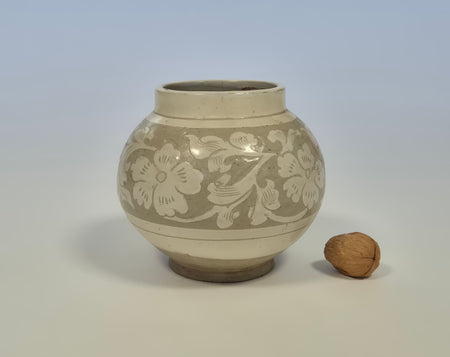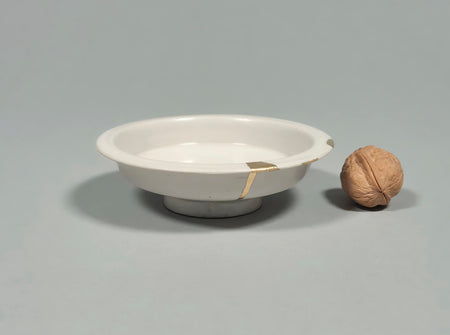Northern white wares

The white ceramics from northern China helped establish the country as a leading ceramics producer as early as the Tang dynasty. These ceramics were strong and durable like the Yue ware from Zhejiang, but they had a more shiny and clean appearance that made them highly sought after worldwide. Porcelain-like white wares had actually been produced around 1800 years earlier, in the Shang dynasty. White unglazed vessels from this period have been found in Anyang, Henan, but the clay was less pure compared to Tang porcelain, and firing temperature was slightly lower.
How ceramics were made in the north was quite different from the south. Nigel Wood's research shows that northern and southern China have different geological compositions. They were once separate land masses that merged about halfway between the Yellow River and the Yangzi River. This geological difference meant that the materials used to make pottery in the north were rich in clay minerals, while those in the south were more rock-based and contained fine particles of quartz and mica. This geological variation influenced how ceramics were crafted in each region. The type of kilns used in northern China were called mantou kilns and were round/horse-shoe-shaped. By the Tang dynasty firing temperatures as high as 1350°C were reached in these kilns. Up to the Five dynasties period these kilns had been fueled with wood, but that changed in the 10th-11th century when coal became available. This made it easier to reach higher temperatures and to achieve oxidised firings, and gave a boost to the ceramic production in many northern kilns.
The two most famous kiln systems producing white ware in northern China were Xing and Ding kilns, situated in the area east of the Taihang mountains in Hebei. They produced white ceramics from the Sui and Tang through Song and Yuan eras.
Xing Kiln
Xing ware was mentioned in literature as early as the Tang dynasty and described as the whitest of northern porcelains. The Xing kiln, long relatively unknown to science, has gradually revealed its secrets through ongoing archaeological excavations in areas like Lincheng and Neiqiu. Since the 1980s, more than twenty sites dating from the Northern Dynasties to the Tang eras have been unearthed, shedding light on its evolution. It's now understood that the Xing kiln's origins trace back to the Northern Dynasties, experiencing its heyday during the middle Tang era, with production gradually declining towards the end of the Tang and into the Five Dynasties periods.
In the Sui dynasty, the ceramic pieces emerging from the Xing kiln were generally rudimentary, though there were occasional examples of finely crafted porcelain-like pieces. In the early Tang period the production of white-glazed wares decreased significantly. The pieces had thick bodies and the glazes were thinner and less transparent compared to previous period. Many pieces during this period were treated with a white slip before glazing. Various shapes were produced, ranging from bowls and dishes to basins, vases, and jars.
The mid Tang period witnessed a resurgence in the production of white wares. Alongside the coarser pieces, potters produced items of exceptional quality, introducing new shapes like handled ewers, cosmetic boxes, cups with saucers, and even small sculptures. The bodies and glazes became noticeably thinner during this period. Towards the late Tang era, the diversity of shapes decreased, and the glazes and clay bodies tended towards a pale yellow hue. While refined pieces were still being crafted, the overall quality began to decline, a trend that continued into the Five Dynasties period.
Excavations at Xing kiln sites have revealed wares bearing official marks like "Ying," "Guan," and "Han Lin," suggesting a connection to the court and royal production. Moreover, simpler Xing wares found their way to distant lands, as evidenced by the discovery of white teabowls in archaeological sites across North Africa and the Middle East, dating back to the 9th and 10th centuries.
Ding Kiln
Xing is often regarded as the greatest kilns of the Tang dynasty, but Ding took over this reputation in the Song dynasty. Jianci village, Quyang county, Hebei, is one of the most significant sites for Ding wares, spanning from the Tang era to the Yuan dynasty's end. During the Tang dynasty, the Ding kiln produced a wide array of ceramics, including dishes, bowls, jars, boxes, ewers, headrests, and vases, characterized by thick, gray bodies, partially covered with glaze.
The Five Dynasties period witnessed a gradual evolution in vessel shapes, with finer bodies and vessels adorned with incised motifs. By the time of the Northern Song dynasty, the Ding kiln had reached its pinnacle, displaying remarkable refinement in dish and bowl types, alongside an increased variety in vessel forms, including intricate figurines.
In the Jin and Yuan dynasties, the Ding kiln continued to produce some fine-quality bowls and dishes, although production eventually waned, and the quality of wares declined. Despite this, Ding kiln ceramics remained notable for their incised, carved, and molded motifs, often embellished with gold, silver, or copper on the vessel rims. This was a way of hiding the unglazed rims which was a result of firing bowls and dishes upside down. The production was highly effective, and by nesting bowls on top of each other during firing, as many as seven bowls of decreasing diameter could be fired on a single setter.
Aside from the renowned Xing and Ding kilns, numerous other kilns across regions like Hebei, Henan, Beijing, Inner Mongolia, Shanxi, Shaanxi, Liaoning, Anhui, and Shandong contributed to the production of white wares. Notably, the Gongyi district in northern Henan emerged as a significant center for high-quality white wares, rivaling the Xing kilns in excellence during the Sui and Tang dynasties.











